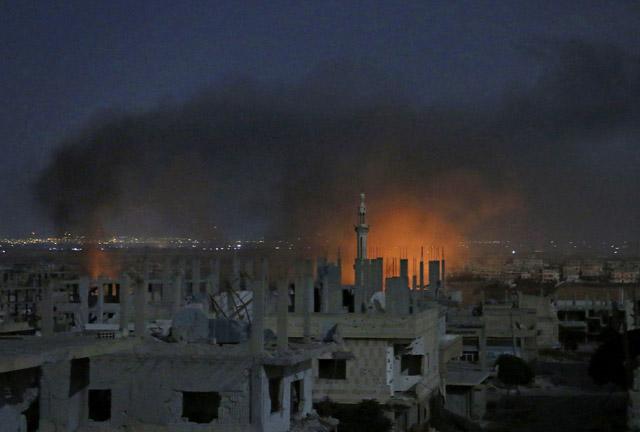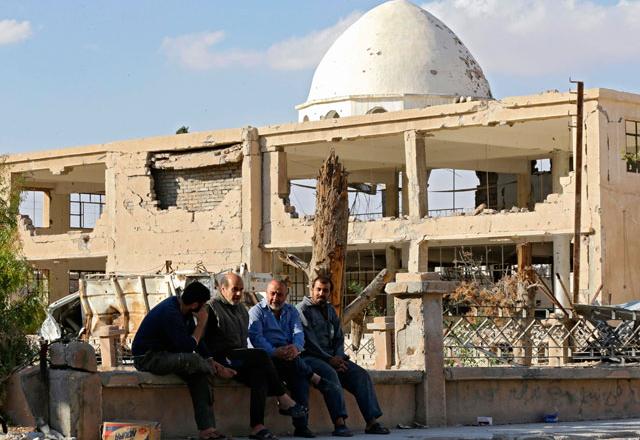You are here
Fifth round of Kazakh Syria talks focuses on safe zones
By AFP - Jul 04,2017 - Last updated at Jul 04,2017

Smoke and flames rise from buildings following a reported government strike on a rebel-held area in Syria’s southern city of Daraa late on Monday (AFP photo)
ASTANA, Kazakhstan — Powerbrokers Russia, Iran and Turkey on Tuesday focused on shoring up a plan for safe zones in Syria at a fifth round of talks they are pushing in Kazakhstan to help end the six-year conflict.
Moscow and Tehran, which back Syrian President Bashar Assad, and rebel supporter Ankara agreed in May to establish four “de-escalation” zones in the war-torn country in a potential breakthrough towards calming a war that has claimed an estimated 320,000 lives.
But while fighting dropped off in the weeks after the deal, it has ratcheted up in some areas since, and the key international players have yet to finalise the boundaries of the zones or determine who will police them.
Russia’s chief negotiator at the talks, Alexander Lavrentiev, told journalists in Kazakhstan’s capital Astana that these issues were “under discussion” and that “an agreement has not yet been reached”.
The two days of meetings, which include representatives of the Syrian regime and rebels, is set to conclude Wednesday with a session attended by all participants. United Nations Syria envoy Staffan de Mistura was also dashing between delegations.
The deal in May roughly laid out the areas where rebels and government forces should halt hostilities, including air strikes, for six months, but Russia, Turkey and Iran have failed to meet a June 4 deadline to set exact boundaries for the zones.
More than 2.5 million people are believed to live in the four areas, which include rebel-held Idlib province, northern parts of Homs province, Eastern Ghouta near Damascus and areas of southern Syria.
A major sticking point still seems to be deciding which countries will ensure security in which areas, with Turkey and Iran reportedly wrangling to bolster their influence.
‘Cessation of hostilities’
The Astana talks received a boost Monday after the Syrian army unilaterally announced a halt to fighting until midnight on July 6 in the southern Daraa, Quneitra and Sweida provinces, which together cover one of the zones.
Daraa had seen the fiercest fighting in the areas envisioned as safe zones in recent weeks.
But an AFP correspondent said air strikes pummelled the key opposition-held town of Douma in a rebel enclave of Eastern Ghouta just outside Damascus on Tuesday for the first time since the de-escalation zones were announced in May.
A medical source told AFP a woman and a child were killed in the raid, a toll confirmed by the Syrian Observatory for Human Rights, which also said that 10 others were badly wounded.
The observatory, a Britain-based monitor that relies on a network of sources inside Syria for its information, said the raids were carried out by Syrian warplanes.
While Damascus has voiced its support for the de-escalation zones, rebel factions have been far more pessimistic and have slammed any Iranian involvement in the plan.
Russia has argued the agreement will help focus attacks against extremist groups such as Fateh Al Sham, previously known as Al Nusra Front, and the Daesh terror group, which are not parties to the troubled truce between the government and rebels.
Syria’s conflict evolved from a bloody crackdown on protests in 2011 to a devastating war that has drawn in world powers, including Russia and a US-led international coalition.
Moscow has pushed the talks in Astana since the start of the year as it seeks to pacify Syria after its game-changing military intervention on the side of Assad.
The talks in Astana are intended to complement broader political negotiations the United Nations is backing in Geneva, which are due to restart in mid-July.
The West has largely been kept on the sidelines of the Astana talks, but Stuart Jones, the top US diplomat for the Middle East, was attending as an observer.
Related Articles
ASTANA, Kazakhstan — A fresh round of peace talks seeking to end Syria's war opened in the Kazakh capital Astana on Monday, as part of a Mos
DAMASCUS — Syria's army announced Saturday a halt in fighting in parts of Eastern Ghouta after rebels and regime ally Russia agreed on how a
ASTANA, Kazakhstan — Russia's envoy for Syria said Thursday that an agreement was "very close" on a fourth safe zone in the country as a new

















